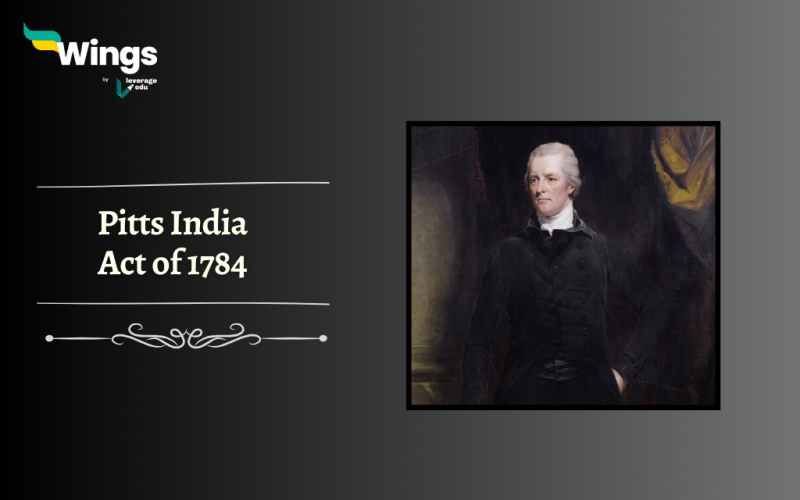During the time of control of the East India Company over the nation, numerous acts and regulations were passed to take complete authority. Among them, the Pitts Act was the initial step towards regulating the affairs of the East India Company in India. For instance, it recognized the political and administrative functions of the government and laid down the foundations of central administration. In this blog, let us delve into the details of the Pitt’s India Act of 1784 along with its features and drawbacks.
Table of Contents
What was Pitt’s India Act of 1784?
The Pitt’s India Act of 1784 is one of the most significant parts of British colonial history that truly reformed India’s governance. Introduced by the then Prime Minister of Britain, William Pitt the Younger, this act aimed to address the corruption, chaos, and other issues that plagued the British East India Company’s rule.
- The Board of Control was created for the jurisdiction of political matters whereas the Court of Directors was formed for commercial affairs, civil, and military matters. Moreover, the Board of Control comprised of six people.
- It included the Secretary of State as the Board President, Chancellor of the Exchequer, and four Privy Councillors.
According to this system, the East India Company was represented by the Court of Directors. On the other hand, the British government was represented by the Board of Control.
Also Read – The Government of India Act 1919
Why was it implemented?
Interestingly, Pitt’s India Act was implemented almost 11 years after the implementation of the famous Regulating Act of 1773. During this period, the East India Company exploited India and its abundance of resources for the betterment and progress of its own. Accordingly, it ended up making huge profits.
This is why the British government felt like taking the administrative control of the Indian subcontinent into its own hands. The loopholes of the Regulating Act of 1773 further caused administrative failures, lack of accountability, mismanagement, and an increase in corruption. Therefore, the British parliament went ahead with introducing the Pitts Act in 1784.
Also Read – Government of India Act 1935: Key Features, Significance and More
Provisions of Pitt’s India Act
There were numerous provisions of Pitts act that contributed to its popularity. Here is what you need to know:
- Owing to the implementation of Pitt’s India Act, the Indian administration’s direct control was shifted into the hands of the British Government.
- The total number of members in the Governor General’s council was reduced to three out of which one would be the Commander-in-chief of the British Crown’s army in India.
- The act further made it mandatory for all civil and military officers to reveal their Indian and Britain properties within a period of 2 months of their joining.
- It also made Calcutta the capital of the British possessions in India.
- The Bombay and Madras Presidency became subordinate to the Bengal Presidency of India.
Also Read – What was the Mountbatten Plan?
Salient Features of Pitt’s India Act
Here are the important features of the Pitts Act:
- The act was named after the then Prime Minister of Britain, William Pitt the Younger.
- The Pitt’s India Act aimed to distinguish between the Commercial and Political activities of the East India Company.
- This act used the term British Possessions in India for the very first time in history.
- Unlike the previous Regulating Act of 1773, the Company became subordinate to the British government.
- Pitts Act also gave the authority over the civil and military administration of Indian territories to the British Crown.
Also Read – What was the Vernacular Press Act of 1878?
Drawbacks of Pitt’s India Act
Here are a few drawbacks of the Pitts Act that might have caused its failure:
- There were no clear boundaries of power between the Court of Directors, the Board of Control, and the Governor-General which created confusion.
- There was an obvious clash of power between the Governor-General and the executive council.
- The reduction of the total number of members required in the council of the Governor-General gave an extra edge. This is because the Governor-General now only needed one vote from the council for his decisions.
- This Act also deprived the Governor-General of their military powers.
Relevant Blogs
| What was the Lucknow Pact? | Charter Act 1833 |
| Indian Councils Act 1909 | Charles Wood’s Despatch |
| Charter Act 1813 | Charter Act 1853 |
| Complete List of Governor General of India | Full List Of Viceroys Of India |
Quiz Time
Results
#1. Pitt’s India Act was named after _____
#2. Pitt’s India Act was implemented in which year?
#3. The total number of members in the Governor General’s council was reduced to ____
That’s all about the Pitts India Act! If you want to know more about topics like this, then visit our general knowledge page! Alternatively, you can also read our blog on general knowledge for competitive exams!
 One app for all your study abroad needs
One app for all your study abroad needs
















